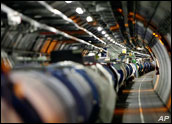
The search for the elusive Higgs boson continues as scientists analyze the data from two recent experiments conducted at CERN, the European organization for nuclear research.
On Tuesday, scientists raised the possibility that the data might indicate that the particle they observed was a Higgs impostor.
While a standard model Higgs boson fits the data from the Large Hadron Collider (LHC), a generic Higgs doublet and a triplet impostor fit it almost as well, according to scientists Joseph Lykken, Ian Low and Gabe Shaughnessy.
“A Higgs impostor is a boson that interacts with other particles in a way similar to a real Higgs, but in fact has a different origin,” Lykken, who works at the Fermi National Acceleration Laboratory (FNAL), told TechNewsWorld.
Looking Good Like a Boson Should
The Standard Model of particle physics holds that all particles can be grouped together according to how they behave under the forces called “weak interactions,” Fnal’s Lykken said. The Higgs boson is a proposed elementary particle in this theory.
The Higgs theory holds that the Higgs boson goes together with three other particles to make a Higgs doublet, but the other three particles are consumed to give mass to the W and Z bosons that carry the weak forces, Lykken said. “A Higgs impostor is a boson that interacts with other particles in a way similar to a real Higgs, but in fact has a different origin.”
Two examples of such impostors were suggested by Lykken and his colleagues. “In one case, the impostor is a ‘singlet,’ meaning it doesn’t have any charge at all under the weak interactions,” Lykken stated. “Another possibility is an impostor belonging to a ‘triplet’ instead of a doublet — nine particles altogether, of which one behaves in a similar way to a Higgs boson.”
Walks Like a Higgs, Talks Like a Higgs, but …
Certain particles can be grouped together, Bill Gary, professor of physics and astronomy at the University of California at Riverside, told TechNewsWorld. For example, when an electron-type neutrino absorbs a W-boson, it turns into an electron and “we say that [they] form an electroweak doublet.”
In the Standard Model, the Higgs is an electroweak “singlet,” meaning it doesn’t have an electroweak partner, Gary said. The triplet impostor is a more complicated Higgs model where each of the three Higgs bosons making it up can turn into the other two by absorbing or emitting W and Z bosons. Calling it an impostor “is merely a cute way to say that it might not be the Standard Model Higgs but merely looks like one based on what we currently know.”
Physicists Just Want to Have Fun
“I think people are getting a little ahead of themselves and having fun doing it,” suggested James Bensinger, professor of physics at Brandeis University.
The Standard Model Higgs boson has several different decay modes, Bensinger told TechNewsWorld. Once the mass is known, the Higgs production cross-section and the exact ratio of the different decay modes are known.
“To say one has found the [Standard Model] Higgs, several different decay modes must be measured and found to agree with the prediction, as must the cross-section,” Bensinger elaborated. “To date, these measurements have not been done accurately enough to prove that the object we observed is the Standard Model Higgs.”
“My guess is that what we have is, in fact, [the] Higgs particle, but perhaps with subtle differences in its properties that will tell us where to look for more LHC discoveries,” FNAL’s Lykken said.
“The question is not whether we have discovered the ‘real’ Higgs, whatever that is,” UC Riverside’s Gary said. “We hope it’s not the Standard Model Higgs because we know [that’s] incomplete and we need a guide on how to extend it to a deeper theory.”





















































